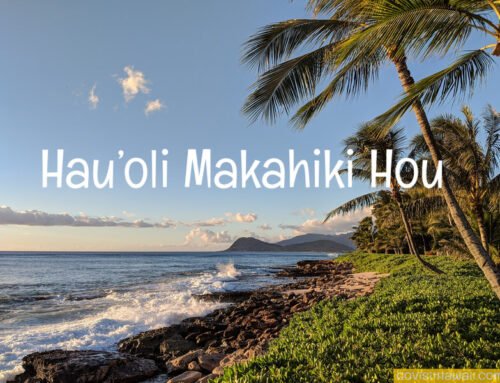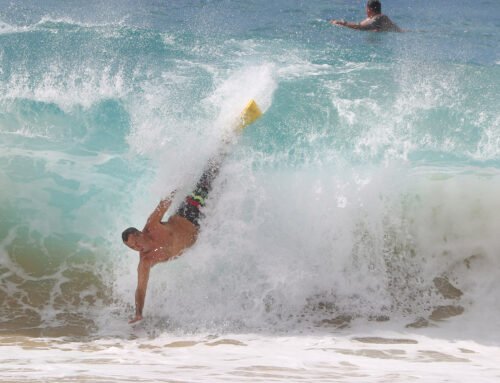State coastal land officials issued notices of alleged violation Thursday to 15 North Shore property owners on Oahu for cutting down native vegetation and trees, as well as moving dirt and spreading mulch in a designated conservation district along the shoreline.
The Department of Land and Natural Resources is investigating how those owners’ actions to alter a stretch of shoreline in Kahuku may have impacted native insect and bird species that depend on those plants along the beach and help the native vegetation to flourish.
That includes one of several Hawaiian yellow-faced bee species that are now endangered largely because human development has wiped out most of their habitat as well as the wedge-tailed shearwater.


Earlier this week, work crews could be seen removing naupaka shrubs and heliotrope trees with machetes and chainsaws just above the shoreline at Marconi Point, an agricultural-designated area next to Turtle Bay Resort.
The landowners could face a fine of up to $15,000 for each violation from the DLNR’s Office of Conservation and Coastal Lands. They could face additional fines of up to $15,000 per day if the activity doesn’t stop, according to a DLNR news release Thursday.


Kahuku is one of the last remaining places on Oahu to find Hylaeus Anthracinus, a coastal bee species that largely depends on naupaka, according to Paul Krushelnycky, an assistant researcher at the University of Hawaii’s College of Tropical Agriculture and Human Resources.
Unlike honeybees, Hawaii’s native yellow-faced bees are solitary insects and use the hollowed-out twigs of naupaka and heliotrope for their nests, Krushelnycky said. They also rely on naupaka for the plants’ pollen and nectar, he added.
The bees pollinate the naupaka and other native plants, Krushelnycky said.
“We do feel that their presence is important” for the islands’ coastal ecosystems to function as efficiently as possible, he added.


Seven species of yellow-faced bee are protected under the Endangered Species Act, according to Krushelnycky. The yellow-faced bee habitat at Marconi Point has been described as among the most robust on Oahu, according to a DLNR release.
State entomologist Cynthia King is investigating what impact that unauthorized shoreline work at Marconi Point may have had on the bees, DLNR spokesman Dan Dennison said.
It’s still not clear which owner at Marconi Point actually initiated the work.
On Wednesday, Lynn Kenton, a spokeswoman for one of the larger property owners at Marconi Point, Makai Ranch, said her company’s understanding was that the work had been done by a new owner who just took control of a shoreline parcel there in the past couple of months. She declined to name the new owner.


State conveyance records show that BSS HI Properties took ownership of a nearly 2.5-acre parcel there on Sept. 1. It did not respond to a request for comment Thursday.
The land is zoned under the categories of agriculture and preservation, according to the Honolulu assessor’s records.
Records further show that another property owner there, popular Chinese-American television host Yue-Sai Kan, applied for a shoreline certification with Honolulu County earlier this year. The application shows several photos with lines added through the vegetation along the shoreline there.
All three of those companies are among the 15 that were served with the notices of alleged violation.
Kan has previously faced scrutiny for building structures on her property there that may not have complied with city regulations, as Enviroment Hawaii reported.
Laysan albatross have also started to nest at Marconi Point in recent years. However, none were believed to have been nesting there at the time of the work and researchers who study say the birds say that the removal of the plants likely won’t stop them from returning.
The birds don’t depend on naupaka and they tend to nest in grassy areas out in the open, according to Eric VanderWerf, science director at the nonprofit Pacific Rim Conservation.
The shoreline where the clearing and mulching took place is located between conservation land owned by Turtle Bay on one side and the James Campbell Wildlife Refuge on the other.
Conservationists have been working in recent years to establish the area as a viable nesting ground for albatross, as climate change continues to erode more of the birds’ habitat in the Northwestern Hawaiian Islands.
Spreading of mulch is prohibited because it’s a breeding medium for the invasive Coconut Rhinoceros Beetle which is infesting and killing native palm trees, DLNR says in its release Thursday.
The violations will be taken up by the Board of Land and Natural Resources as soon as possible, the release says, and the landowners have 30 days in which to propose potential mitigative actions for consideration.
Civil Beat’s coverage of climate change is supported by the Environmental Funders Group of the Hawaii Community Foundation, Marisla Fund of the Hawaii Community Foundation and the Frost Family Foundation.







Leave A Comment